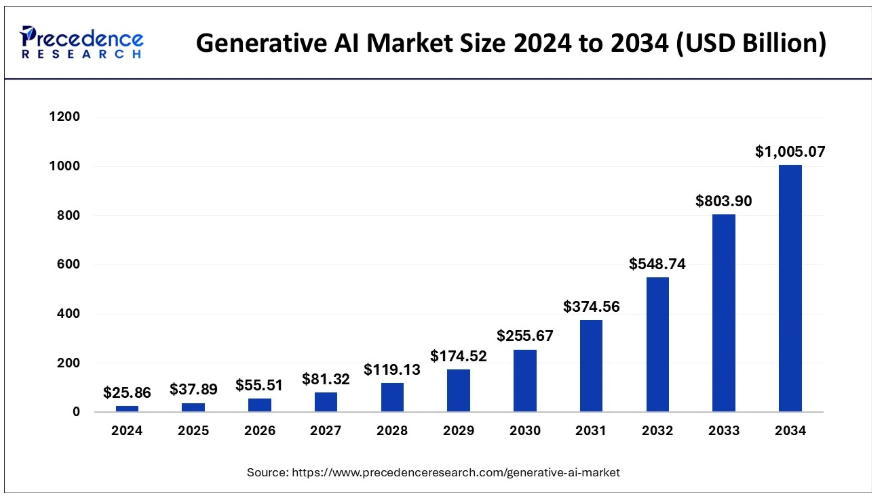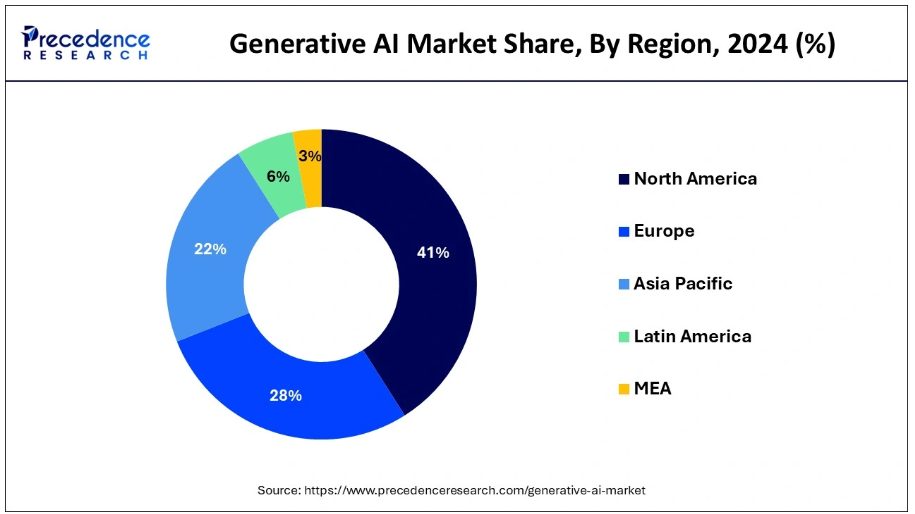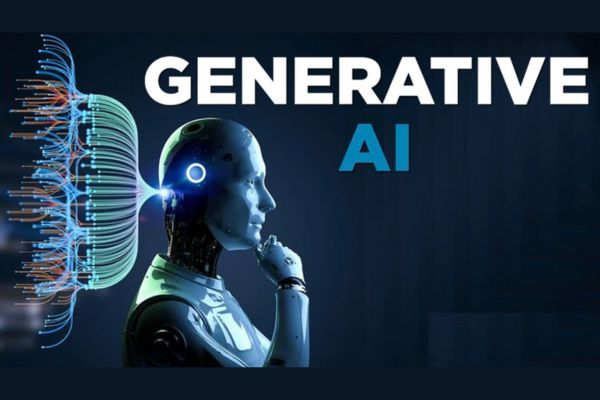According to Precedence Research, the generative AI market size is expected to attain around USD 1005.07 billion by 2034 from USD 25.86 billion in 2024 with a CAGR of 44.20%. The North America generative AI market size surpassed USD 10.60 billion in 2024 and is expanding at a CAGR of 10.60% during the forecast period.

Generative AI Market Key Points
- The North America market accounted for 41% of total revenue in 2024.
- The Asia Pacific market is projected to grow at a CAGR of 27.6% between 2025 and 2034.
- By component, the software segment held a dominant revenue share of over 65.5% in 2024.
- By technology, the transformers segment led the market with a revenue share exceeding 42% in 2024.
- By end-use, the media & entertainment sector captured more than 34% of total revenue in 2024.
- By end-use, the business and financial services sector is anticipated to grow at the fastest rate, with a CAGR of 36.4% from 2025 to 2034.
What is Generative AI?
Generative AI refers to a type of artificial intelligence that can create new content such as text, images, videos, music, or even code by learning from existing data. Unlike traditional AI models that focus on pattern recognition or predictions, generative AI can produce entirely new data that closely mimics the patterns and structures it has learned from its training datasets.
Key Models of Generative AI
- Generative Adversarial Networks (GANs): These consist of two neural networks, a generator and a discriminator, that work against each other to create realistic outputs. GANs are particularly used for generating high-quality images and videos.
- Variational Autoencoders (VAEs): VAEs help in generating new data by learning the distribution of a dataset and sampling from it to create new examples, often used in image and speech generation.
- Transformers: AI models like GPT (Generative Pretrained Transformer) are designed to generate human-like text. These models use attention mechanisms to create coherent and contextually relevant content, and they can extend to multimodal tasks, such as generating images or videos from text prompts.
Applications of Generative AI
- Text Generation: AI models like GPT-3 and GPT-4 can generate realistic and coherent text for content creation, writing articles, answering questions, or even composing poetry and code.
- Image Generation: Models like DALL·E and Stable Diffusion generate detailed images from textual descriptions, offering new possibilities in design, advertising, and digital art.
- Audio and Video Synthesis: Generative AI can create realistic audio or video, including the generation of deepfake videos or virtual voices for media production.
- Music Composition: AI models are also used to compose original music by analyzing existing music data and learning patterns, enabling music production in various genres and styles.
- Game Development: AI can be used to procedurally generate game environments, characters, and levels, creating unique and dynamic gameplay experiences.
Regional Outlook of Generative AI Market

North America
North America leads the global generative AI market, accounting for over 41% of the total revenue share in 2024. The region’s dominance is driven by rapid adoption of advanced AI technologies across industries, strong investments in R&D, and the presence of major technology players such as Google, Microsoft, Meta, and Apple. The U.S. is a powerhouse, with a market size estimated at USD 7.41 billion in 2024 and projected to reach USD 302.31 billion by 2034, growing at a CAGR of 44.9%.
Key growth drivers include the increasing use of generative AI in banking and finance for fraud detection, the proliferation of AI-powered media and entertainment applications, and the modernization of workflows through automation. Additionally, North America benefits from robust cloud infrastructure and a high level of digital transformation across sectors.
Asia Pacific
Asia Pacific is set to be the fastest-growing region in the generative AI market during the forecast period. This rapid expansion is fuelled by strong government initiatives supporting AI research, a surge in AI-based application deployment, and increasing investments in digital transformation. Countries like China, Japan, South Korea, and India are at the forefront, leveraging generative AI in sectors such as healthcare, manufacturing, and finance.
The region’s large population, expanding tech ecosystem, and rising demand for automation and remote monitoring are accelerating adoption. Additionally, Asia Pacific is seeing a growing number of startups and collaborations focused on AI innovation, positioning the region as a major hub for future generative AI development.
Europe
Europe is witnessing significant growth in the generative AI market, supported by robust regulatory frameworks, increasing digitalization, and strong investments in AI research and development. The European Union’s focus on ethical AI and data privacy is shaping the adoption of generative AI technologies, particularly in sectors like healthcare, automotive, and financial services.
Leading economies such as Germany, the UK, and France are driving adoption through public-private partnerships, government funding, and a thriving startup ecosystem. Europe’s emphasis on responsible AI and its integration into critical industries are expected to support steady market growth in the coming years.
Get the Sample Copy of Report@ https://www.precedenceresearch.com/sample/2503
Market Scope
| Report Coverage | Details |
| Market Size in 2025 | USD 37.89 Billion |
| Market Size by 2034 | USD 1005.07 Billion |
| Growth Rate from 2025 to 2034 | CAGR of 44.20% |
| Base Year | 2024 |
| Forecast Period | 2025 to 2034 |
| Segments Covered | By Component, By Technology, By End-Use |
| Regions Covered | North America, Europe, Asia-Pacific, Latin America, Middle East & Africa |
Generative AI Market Companies
Synthesia: Synthesia is a leading AI video generation platform that enables users to create studio-quality videos featuring realistic AI avatars. The platform is widely used for training, internal communications, marketing, and localization, supporting over 140 languages and offering more than 230 avatars.
Synthesia’s technology leverages generative AI to automate video production, making it accessible and scalable for businesses of all sizes, including major corporations like Reuters, Zoom, and Amazon.
MOSTLY AI Inc.: MOSTLY AI specializes in synthetic data generation using generative AI. Their platform creates high-fidelity synthetic datasets that retain the statistical properties of real data while ensuring privacy and regulatory compliance.
This technology is crucial for AI/ML development, data sharing, testing, and analytics, enabling organizations to work with realistic data without exposing sensitive information.
Genie AI Ltd.: Genie AI uses generative AI to transform legal services. Its platform provides an AI-powered legal assistant that helps users understand, customize, and negotiate legal documents.
Genie AI maintains the world’s largest open legal library, enabling businesses to access, edit, and collaborate on legal templates efficiently and affordably. The company is recognized for making legal expertise more accessible through natural language processing and machine learning.
Amazon Web Services, Inc. (AWS): AWS plays a foundational role in the generative AI ecosystem by providing cloud infrastructure, pre-trained foundation models, and AI services. Its platform supports the building, training, and deployment of generative AI applications at scale, with a focus on security, privacy, and cost-effectiveness. AWS enables organizations to customize generative AI for their specific data and use cases, accelerating innovation across industries.
IBM: IBM is a major enterprise provider of generative AI solutions, offering tools like watsonx™ Assistant and watsonx.ai™ Lightweight Engine. IBM’s generative AI technologies focus on product development, automation, conversational AI, and code generation, with an emphasis on security, explainability, and trustworthiness.
IBM supports businesses in embedding AI into commercial applications and optimizing technical and customer-facing processes.
Google LLC: Google is a key player in generative AI, providing advanced AI models and cloud-based tools for a wide range of applications. Google’s generative AI solutions are used globally for content creation, business automation, and industry-specific use cases.
The company’s AI infrastructure supports both startups and enterprises in deploying scalable, production-grade generative AI systems.
Microsoft: Microsoft is a global leader in the generative AI market, integrating AI capabilities into its Azure cloud platform and productivity tools. The company collaborates with OpenAI and offers services that enable organizations to build, deploy, and scale generative AI applications for business, productivity, and creative tasks.
Microsoft holds a significant share of the generative AI market, emphasizing enterprise adoption and integration.
Adobe: Adobe leverages generative AI primarily in the creative sector, integrating AI-powered features into its suite of design and media tools. Adobe’s generative AI enables users to automate image, video, and content creation, enhancing productivity and creative possibilities for professionals in design, marketing, and media.
Rephrase.ai: Rephrase.ai utilizes generative AI to create personalized video content at scale. The platform allows businesses to generate customized videos for marketing, sales, and communications by synthesizing human-like avatars and voices from text input, streamlining the process of personalized content creation.
D-ID:D-ID specializes in generative AI for video and image animation. Its technology enables the creation of photorealistic talking avatars from still images, widely used for marketing, entertainment, and customer engagement. D-ID’s solutions make it easy to generate engaging, AI-powered video content from simple photos or text scripts.
Segments Covered in the Report
By Component
- Software
- Services
By Technology
- Generative Adversarial Networks (GANs)
- Transformers
- Variational Auto-encoders
- Diffusion Networks
By End-Use
- Automotive & Transportation
- BFSI
- Media & Entertainment
- IT & Telecommunication
- Healthcare
- Others
Source: https://www.precedenceresearch.com/generative-ai-market


















